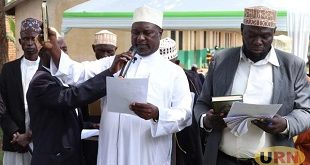
Paris, France | AFP | Deadly protests that have grown across Sudan in recent weeks are the biggest threat to President Omar al-Bashir’s iron-fisted rule since he swept to power in a 1989 coup, experts said.
Clashes have killed at least 19 since demonstrations began two weeks ago, initially in protest against bread prices tripling but rapidly evolving in to anti-government rallies.
Rights group Amnesty International has put the death toll at 37 and United Nations Secretary General Antonio Guterres has called for an investigation.
“These demonstrations and the anger that animates them are much stronger than any we’ve seen in recent years,” said Eric Reeves, a senior fellow at Harvard University who has been tracking Sudan’s politics and economy for two decades.
“The shortage of bread … and outrageous price increases is perhaps the greatest source of immediate popular anger, and there is nothing that can alleviate the problem,” Reeves told AFP.
Protests erupted when the government raised the price of a small loaf of bread from one Sudanese pound to three (from about two to six US cents).
Several buildings and offices of Bashir’s ruling National Congress Party (NCP) were torched in the initial violence.
Some protesters have also adopted the slogan used in the 2011 Arab Spring — “the people want the fall of the regime”.
Bashir, wanted for genocide by the Hague-based International Criminal Court over a conflict in Darfur, came to power in a coup backed by Islamists that toppled prime minister Sadiq al-Madhi and his democratically elected government.
Since then the former military general has ruled the African country with a tight grasp, using the feared National Intelligence and Security Service (NISS) to curb dissent.
NISS agents regularly arrest opposition leaders, activists and journalists who voice anti-regime opinions.
– Dilapidated economy –
Bashir, 75, took control at the height of a brutal north-south civil war that only ended in 2005. Oil-rich South Sudan seceded in 2011, becoming the world’s newest nation state.
Separate conflicts between Sudanese forces and rebels in Darfur, Blue Nile and South Kordofan states have also killed hundreds of thousands of people and displaced millions.
Analysts say these conflicts and a failure to boost agriculture in a country once renowned as a major bread producer have left Sudan’s economy in a shambles, despite Washington lifting a two-decade trade embargo in 2017.
Secession by the south — which took three quarters of Sudan’s oil reserves — has seen Khartoum experience an acute foreign exchange shortage.
Inflation has soared to 70 percent while shortages of bread and fuel have hit the capital and other cities.
“The economy has been collapsing for almost a decade … but the regime functions as a kleptocracy and maintains power only through national budgets that are wildly skewed to military and security service expenses,” said Reeves.
“I think the anger we’ve seen will not dissipate.”
The ongoing protests are more widespread than those in January 2018 and September 2013.
They began first in outlying towns and cities, which had been left with a particularly acute shortage of wheat and flour, after supplies were diverted to Khartoum.
But despite the attempts to stockpile in the capital, the protests still spread there.
“The government and the ruling party was caught by surprise when protests erupted outside Khartoum,” said Khalid Tijani, editor of economic weekly Elaff.
“It just showed the ruling NCP how isolated it is.”
After three days without major demonstrations, the opposition and activists have called for further protests after prayers this Friday.
 The Independent Uganda: You get the Truth we Pay the Price
The Independent Uganda: You get the Truth we Pay the Price



